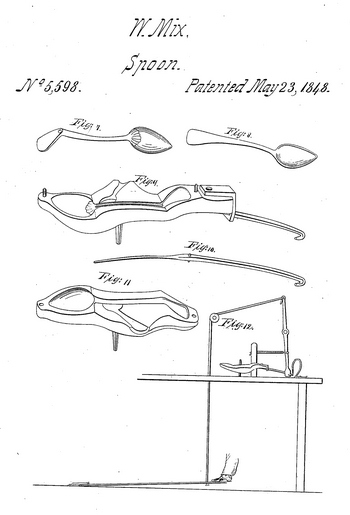William Mix
- Born: 27 May 1788, Wallingford CT
General notes:
Pewtersmith
Events in his life were:
- He worked in 1827-1850 as a pewtersmith in Prospect CT 11
- Master: Charles Parker, circa 1830, in Prospect CT. 11
- Master: Robert Wallace, in 1831-1833, in Prospect CT.

- Patent: 5,598, on 23 May 1848. WILLIAM MIX, OF PROSPECT, CONNECTICUT.
IMPROVEMENT IN THE MANUFACTURE OF SPOONS.
Specification forming part of Letters Patent No. 5,598, dated May 23, 1848.
To all whom, it may concern:
Be it known that I, WILLIAM MIX, of Prospect, in the county of New Haven and State of Connecticut, have invented a new, useful, and improved spoon made of britannia, block tin, or any suitable metal for casting, with the handle strengthened by wire embedded by a new and improved method, of which the following is a specification.
The nature and object of my invention are to strengthen the handle by a larger wire than has been heretofore used, to inclose it wholly out of sight, and to consolidate the metal around it. This I effect by casting the handle hollow by means of a draw-tap or a core, and securing the wire firmly in place by force of a die and drop, which gives also a smooth surface for finishing.
To enable others skilled in the art to make and use my invention in the manufacture of spoons, I describe the spoon and the method of making it in the various ways of applying the principle of the invention as follows, referring for further illustration to the drawings accompanying this specification as part thereof.
The mode which I prefer, and which is seen fully exhibited in Figure 7, shows a casting on a draw-tap, with the end of the thin part of the handle turned up to admit the tap to penetrate the solid part of the handle. The spoon thus cast, and the wire, made a little shorter than the depth of the hole in the handle, is inserted, and the handle being placed in the dies is brought to-its proper shape by the stroke of the drop, condensing the metal around the wire, and, wholly filling the orifice, exhibits the finished spoon, as seen in Fig. 8.
To show more clearly the operation of the draw-tap. Fig. 9 exhibits the bottom, part of a mold with a draw-tap in place for casting spoons according to the method last described, and which I prefer. Fig. 10 exhibits the draw-tap by itself, curving according to the curve of the spoon-handle and the mold. Fig. 11 exhibits the upper part of the mold. Fig. 12 exhibits a method by which the tap may be speedily withdrawn by a treadle and returned in place by a spiral spring.
The advantages of this invention over other methods of casting wire-handled spoons are that larger wire can be inserted in this mode of casting than by any other method in use.
Of course the saving of stock will be an object, and the spoon will be stronger. The operation of casting on a draw-tap will be much quicker than on wire to be fixed in place for. each casting. The preparation of wires for casting on them is laborious, and not only takes time, but is attended with waste and loss of wire, whereas the wires for inserting in the improved mode need no preparation, but simply cutting them of proper length by gage from the circular skein without straightening, the curve of the skein in which wire is usually wound, corresponding with the curve of the handle, of course without any loss of wire, and spoons so made are not only better, but are made with much less expense.
I do not claim as my invention simply strengthening spoon-handles by wire. That has long been known and done; but I do claim as my invention and improvementó
A new and improved method of strengthening the handles of spoons by wire by casting the handles hollow by means of a draw-tap, and placing the wire therein, and by means of a drop with -suitable dies condensing and closing the metal around the wire with a smooth surface for the last finish, in the manner substantially as above specified, and therefor I solicit Letters Patent.
William Mix
Witnesses:
Simeon Baldwin
John S. Rice
|

